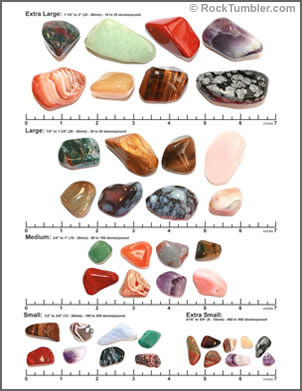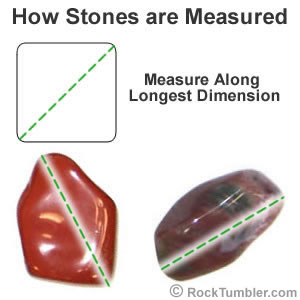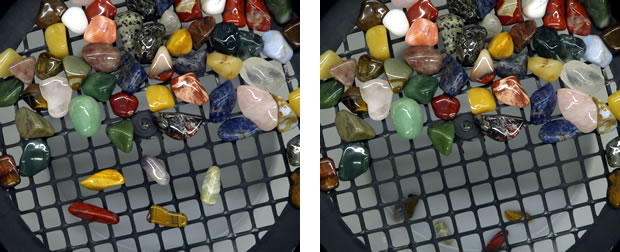Tumbled Stone Buying Guide
What you need to know when buying tumbled stones.

Our printable tumbled stone size chart illustrates the size of the stones in our tumbled stone mixtures. When printed, it shows the size of extra large, large, medium, small and extra small stones at close to their actual dimensions.
About Our Tumbled Stones
We sell two tumbled stone products:
1)
Tumbled stone mixtures in five different stone sizes: extra large (1 1/8 to 2 inches), large (7/8 to 1 3/8 inches), medium (5/8 to 1 inch), small (1/2 to 3/4 inches), and extra small (5/16 to 5/8 inches).These mixtures are called "Natural Mix" because the stones are their natural color - they have not been dyed to alter their color. They are sold in one-pound, three-pound, and ten-pound packages. They are also available in bulk packages of 10, 20, and 40 pounds.
Each package contains a mix of several different gemological varieties - and is randomly scooped from the production stream of a manufacturer. See the section "How Many Kinds of Stones Will Be in Your Package" below for more details about this.
2)
We also sell over 80 varieties of tumbled stones in single-variety packages. These packages contain premium quality stones, all of the same gemological variety. Most are medium in size (5/8 to 1 inch), but a few varieties are sold in other sizes.In our opinion, these stones are breathtakingly beautiful, top quality, and each is an accurate representation of its gemological variety. We love opening the barrels of our shipments to see what we have received - and we believe that you will have a similar experience when you buy them.
How Big Are Our Tumbled Stones?
To help you understand the size of our tumbled stones before you make a purchase, we have created a printable size guide. When you print it, you will be able to see photos of different size stones at close to their actual dimensions.
We believe that it will print from your computer at close to the correct scale. If you want to confirm that, simply get a ruler and compare it to the measurement scale on our document.
We encourage all of our customers to print this chart. It will help you feel comfortable in selecting the proper size stones for your project. Thank you!
How Many Stones Are In a Pound?
The printable size guide described above lists the approximate number of stones that should be contained in one pound of our tumbled stone mixtures. (This information is also on the pages where our tumbled stone mixtures are sold.) For example, packages of medium-size Natural Mix usually contain about 70 to 110 stones per pound. These numbers will vary depending upon the size of the stones and upon their specific gravity.
If you are purchasing the single-variety stone packages, a few types of stones have a higher-than-average or lower-than-average specific gravity. That means they are heavier or lighter than the typical stone of similar size. For example, dumortierite will have about 50 to 90 stones per pound, fluorite 60 to 90, hematite 35 to 55, jet 60 to 80, rhodonite 55 to 85, etc. Please read the stone description to know how many stones per pound you are likely to receive. We update our website with our best estimates each time we receive new stock from our suppliers.
How Are the Stones Measured?
The stone sizes that we sell are summarized in the table below. This table lists: A) the name of the size; B) the approximate range of stone dimensions for that size (in inches); and, C) the approximate number of stones per pound. This data applies to the tumbled stone mixtures that we sell on our main mixtures page and on our bulk pricing page.

This image shows how to measure the maximum dimension of a stone.
Stone Mixture Sizes | ||
| Size | Approximate Dimensions (Inches) | Approximate Stones per Pound |
| Extra Large | 1 1/8 to 2 | 16 - 24 |
| Large | 7/8 to 1 3/8 | 32 - 48 |
| Medium | 5/8 to 1 | 70 to 110 |
| Small | 1/2 to 3/4 | 180 to 250 |
| Extra Small | 5/16 to 5/8 | 450 to 550 |
The sizes in the table above are approximate. The size of a stone is determined by measuring its maximum dimension. This could be measured as a maximum diameter for a round stone, or, the maximum diagonal length for angular and tabular stones. (Please see the accompanying photo.)
How Are The Stones Sized?
All of the stones that we sell are size-sorted by screening. For that reason you will find some oversized and some undersized stones in every bag that you purchase. However, MOST of the stones should be within the specified size range. However, you WILL find larger stones that slipped through the openings of the screen and smaller stones that did not slip through the openings of the screen.
Our prices would be a lot higher if we measured each stone by hand - especially for the smallest stone sizes! We hope that you agree that a few mis-sized stones are a small trade-off for a large savings in price. :-)

Above you can see what sizing stones with a screen would be like. All of these stones were pulled from our extra large inventory. Note: In the photo on the left, you can see 5 elongate stones on top of the screen near the bottom of the photo. In the photo on the right, I took those stones and put them in an orientation in which they could fit through the screen. Those stones are now considered to be the next size smaller. A similar thing could happen where smaller stones end up sitting on top of the larger stones, never falling through the screen. This is why you should expect some stones to be outside of the stated range.
Expect Some Broken or Chipped Stones
Stones that are medium size and larger receive a quick visual inspection from one direction, and any that are broken or have more than a minor blemish are removed before packaging. That's it. We don't pick them up and examine them from every angle, because the labor required to do that would at least double the price that we must charge. So, we guarantee that you will find a few damaged stones. Please expect to find them.
The small and extra small sizes are not inspected - at all. You will find numerous broken and chipped stones in these smaller sizes, especially in the extra small. This breakage occurs during the tumbling process. If we hand-inspected every stone, from every angle, the price we would be forced to charge would be five to ten times higher than the price that we are asking because of the labor required.
How Many Kinds of Stones Will be In Your Package?
The number of varieties depends upon the size of the stones that you purchase and also the size of the package. The smaller the stones, the greater the number of varieties. Also, the larger the package, the larger the number of varieties in your package. In the table below we demonstrate the number of varieties that you might expect, using a three-pound package as an example.
Also, please be aware that the varieties of stones that you receive will change from package to package, and the stones that we are selling today will be different from the stones that we will be selling tomorrow. The packages are made using the stones flowing through the manufacturing process at any given time.
| Stone Size | Stones Per Pound | Number of Varieties to expect in a 3-pound package* |
| Extra Large | 16 - 24 | 8 - 12 |
| Large | 32 - 48 | 10 - 16 |
| Medium | 70 - 110 | 12 - 20 |
| Small | 180 - 250 | at least 16** |
| Extra Small | 450 - 550 | at least 16** |
** Many varieties of tumbled stones have features that are larger than what can be observed in small and extra small stones. This makes small stones harder to identify with confidence.
The stone varieties commonly found in our tumbled stone mixtures include apricot agate, banded amethyst, banded carnelian, blue lace agate, Botswana agate, brecciated jasper, carnelian agate, crystal quartz, dumortierite, green aventurine, moss agate, hematite, leopard skin, lilac amethyst, picture jasper, pink Botswana agate, red jasper, rose quartz, snowflake obsidian, tiger's-eye, tree agate, turritella agate, unakite, yellow jasper, zebra marble, yellow quartz, and other common materials. You should not expect to find high-value or rarer varieties in these mixtures.
Identifying Tumbled Stones
Many people want to identify the stones they have purchased. Most of the stones in packages of natural mix can be identified by comparing them with the large photos on the page where we sell single-variety packages of tumbled stones. Photos of less common varieties of tumbled stones can be viewed on our picture identification guide page.
These photos will give you some idea of what various stones look like - but other varieties of stones can have a very similar appearance. What we are telling you here is that if you find a photograph that is similar to your stone in color, pattern, and other attributes, you have probably identified it correctly - but it is possible that your identification is incorrect.
You should also know that the smaller the size of a tumbled stone, the more difficult it is to identify. This is because the stone might not be large enough to show the full color pattern of that type of stone, and the stone might be so thin that its full color is not clearly displayed.
Confessions of Experts:
"We have been involved with tumbled stones for decades and we encounter lots of stones in Natural Mix that we are unable to identify by visual inspection alone. We experience this EVERY SINGLE DAY."
Positive identification of many tumbled stones often requires examination of the stone by a person with an educational background in geology and gemology, who uses a variety of special tools. To identify some stones we use a gemological microscope, refractometer, polariscope, dichroscope, spectroscope, specific gravity testing equipment, ultraviolet lamp, hardness testing equipment, and numerous other tools. This takes quite a bit of time, and we still may not have an identification we are confident with.
When knowing the identity of a stone is very important (like when we are going to offer the stone for sale and we don't agree with, or doubt, the identity provided by our supplier) we submit the stone to the Gemological Institute of America (GIA) laboratory, where their experts examine it and send us a report.
The cost of their service is usually about $100 (lab fee and shipping). That fee is a bargain, considering the amount of time we would spend examining the stone with all of the equipment above. And, for that reason, we do not provide a stone identification service. We refer those who need it to GIA's lab where your stone will be identified by a consensus of experts.
Place a Small Order the First Time
If you are uncertain about what size to purchase, we recommend purchasing a one-pound or three-pound package to become familiar with the stones. If the size does not suit your needs, it is a lot easier and less costly for you to return a small package than it is to return forty pounds of stones.
Just telling you now... We don't hesitate to decline orders when first-time customers place orders for enormous quantities of stones. We suggest that they purchase a small quantity to see if the size, shape, color, etc. of the stones meet their expectations. It's rare when our stones get returned, but we want to protect your wallet from the cost of returning a hundred pounds of stones from thousands of miles away.
If the stones that you receive are not suitable for your intended use, they can be returned for a refund of the purchase price if they are still in their original bag and the bag is unopened. Shipping and handling fees are not refunded or reimbursed if the stones are "as described" on our website and in conformance with what we have described on this page.
Hand-Picking Stones for Customer Orders
Many customers have asked us to pick out stones of a certain size, a certain shape, a certain color, etc., etc. That seems like a simple request.
In the early years of our business we tried to do this. However, we learned from experience that we are unable to offer this service. So, for over 95% of the time that we've been in business, we have declined all requests to hand-pick special stones to meet customer requirements - even if they offered to pay us extra, even when they told us that they would buy elsewhere, and, most regrettably, even when we really wanted to help them. A bit of our education is summarized below.
1) If we hand-picked stones of special sizes, shapes, or colors for five customers before you, then you will not receive a nice variety of stones in your order. Someone else received the choice stones. We learned that we must decline picking out special stones to preserve the quality and variety of stones available to all customers.
2) We learned how time-consuming it is to pick stones of a certain color, size, shape, etc. We have a very small staff, and picking special stones incurs a high cost that we cannot absorb - and charging for that time makes the stones unreasonably expensive.
3) We've spent lots of time hand-selecting stones, only to have customers send them back to us.
If you need stones of a certain size, color, shape, or other specification, the best way to get them is to visit a rock shop that allows you to pick through their stones and pay for the ones that you decide to take home. (We do not offer that service here. We do not have a walk-in store and only sell pre-packaged stones through this website.) To help you, we have a list of rock shops on this website, and SOME OF THEM allow customers to pick through small bins or baskets of stones. Call before you visit. Many shops do not offer that service, and their policies can change.
Uses for Tumbled Stones
We have an article titled "Uses of Tumbled Stones" that shows a few of the many ways that tumbled stones are used. Some of these examples were submitted by our customers and some by our staff. Small and extra small stones are often used in craft projects. Medium stones are the most popular and are used in jewelry, vases, games, potted plants and much more. The larger stones are popular as "giveaways", lucky stones, accents in planters, meditation stones and much more. You will probably think of even more ideas for your stones.
Thank You for Reading
We appreciate it that you read or skimmed the information above. Our favorite customers are the ones who spend time learning.
RockTumbler.com Authors
 |
Hobart M. King has decades of rock tumbling experience and writes most of the articles on RockTumbler.com. He has a PhD in geology and is a GIA graduate gemologist. He also writes the articles about rocks, minerals and gems on Geology.com. |

